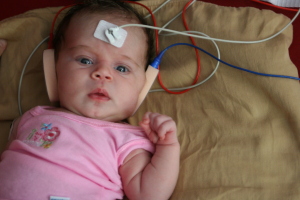Newborn hearing screening is a component of the newborn screening program mandated by the Commonwealth of Pennsylvania. In the first month of life, all infants are to be screened for congenital hearing loss by a hearing specialist or audiologist.
The National Institute on Deafness and Other Communication Disorders (NIDCD) estimates that 2 or 3 out of every thousand children in the US are born deaf or hard of hearing. The purpose of early screening is to ensure that all babies with suspected hearing loss have the opportunity to benefit from early intervention that could support development of language skills.
Auditory Brainstem Response Screening (ABR )
ABR screening is performed by introducing a soft clicking sound to each ear through the use of earphones placed on the infant’s ear or placed at the opening of the ear canal. Adhesive electrodes are taped to various sites on the infant’s head, which are able to monitor and record the auditory response as it travels from the ear through the auditory system. The ABR response provides information regarding the integrity of the auditory pathway up to and including the brainstem.
Automated ABR screening differs from a diagnostic ABR study in that the equipment is fully automated, eliciting either a pass or refer response. A diagnostic ABR evaluation allows the audiologist the opportunity to manipulate the test parameters, e.g., the stimulus (click or tone burst); the intensity of the signal and the method of stimulus presented (air conduction versus bone conduction). Additional information regarding diagnostic ABR evaluation is included in the Diagnostic Testing section of this website.
This test is routinely performed prior to discharge on babies born in hospital. For babies born at home, Motherland Midwifery can perform this test at your 2-3 week office visit or you can arrange it through your pediatrician or a local audiologist. Insurance will cover this test.
You can also contact the New Department of Health and Senior Services or the Pennsylvania Department of Health for more information.
